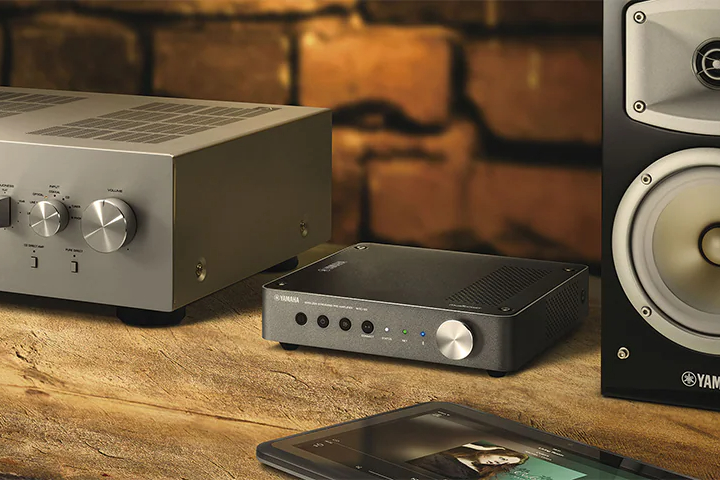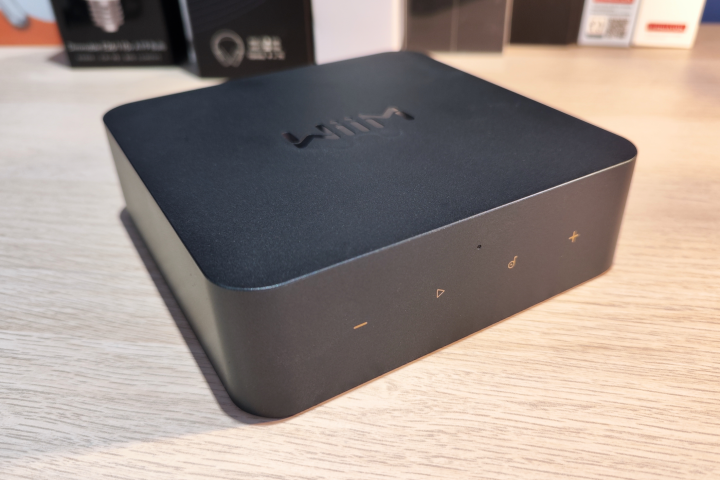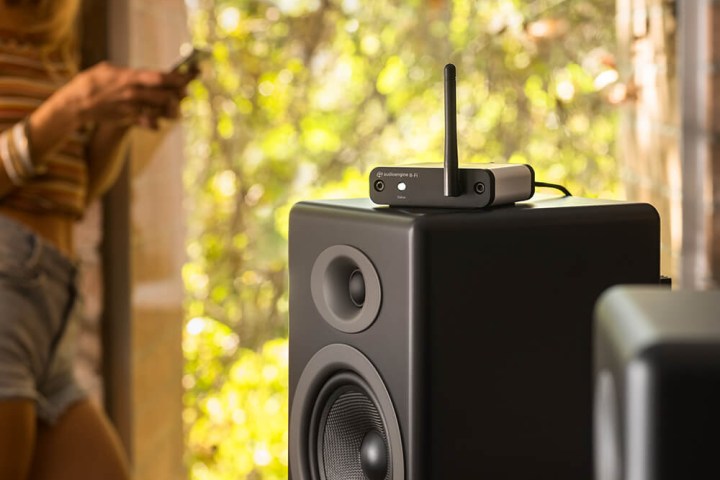Whether your home hi-fi system is a beautiful vintage receiver and speakers, a modern pair of powered speakers, or something in between, adding a dedicated network music streamer to your setup is one of the best ways to bring hi-quality digital music from your streaming services or local files to life.
These internet-connected devices come in all shapes, sizes, budgets, and capabilities, and they work with the latest and best streaming music subscription services, from Spotify, Apple Music, and Tidal to Amazon Music, Qobuz, Deezer, and more. Connectivity options with network music streamers are vast, making them easy to hook up through input/outputs such as RCA, optical, USB, XLR, HDMI, Bluetooth, AirPlay, Chromecast, and many more. Some network music streamers have their own built-in amplifiers so you just need to add speakers, while most are meant to bring all that excellent digital sound to your existing system.
Whichever way you go, if you’re new to the world of network music streamers, choosing can be tricky, so we’ve put together this list of some of the best to help you make your decision.
Cambridge Audio CXN V2
Best overall music streamer
Pros
- Celebrated Cambridge Audio sound
- A wide range of inputs/outputs
- Excellent app control
- Broad file support
Cons
- A bit on the expensive side
- Bluetooth transmitter is separate
Do you expect nothing but supreme audio quality from your network music streamer? For those of us with big listening expectations and money to spare, the Cambridge Audio CXN V2 comes from the esteemed British audio makers and should be your premium network streamer of choice.
Under its sexy brushed metal finish are two 24-bit Wolfson DACs, partitioned internals for the best noise and distortion reduction in town, and a maximum playback resolution of 24-bit/384kHz. Supported hi-res formats include FLAC, ALAC, WAV, PCM, and DSD, and you’ll be able to stream your tunes via Bluetooth, Apple AirPlay, Chromecast, UpNp, and Roon. There’s also native support for Spotify, Tidal, and Qobuz platforms. With Wi-Fi and LAN network connectivity, the CXN V2s inputs include two USB-A ports and a USB-B port, as well as optical and coaxial. Outputs include balanced XLR, line level, and coaxial and optical.
You can also download the StreamMagic app (iOS and Android) to control and customize your CXN. No, it’s not cheap, but if you’re looking for a music streamer that can handle just about anything, the Cambridge Audio CXN V2 is the component for the job.

Cambridge Audio CXN V2
Best overall music streamer

Yamaha WXC-50
Solid compact streamer with built-in preamp
Pros
- Built-in preamp
- Compact design can stand vertically
- Excellent DAC
Cons
- No native support for Apple Music, Qobuz, or Amazon Music
When it comes to overall performance, features, and value, we believe the Yamaha WXC-50 is a great mid-priced option for users looking for a network streamer that includes a built-in preamp, making it ideal for those of us who want to dedicate all our AV ins, outs, and EQ to a single device. It also has a pretty small footprint and can be mounted vertically to save even more space.
Outfitted with a ESS Sabre DAC and an onboard music enhancer for touching up your MP3s, the name of the game is precise and rich sound at a price that doesn’t frighten. You can connect to the WXC-50 using Bluetooth, Wi-Fi, or via wired Ethernet, and the device supports several popular streaming platforms, including Spotify Connect, Pandora, and SiriusXM. Sadly, there is no native support for Apple Music, Qobuz, or Amazon Music.
You’ll also be able to download the MusicCast app (for iOS and Android) to control the streamer with your smartphone or tablet, as well as link the WXC-50 to other wireless Yamaha gear for multi-room audio. Its $450 price puts it smack in midrange territory.

Yamaha WXC-50
Solid compact streamer with built-in preamp

Wiim Pro
Best budget-friendly network music streamer
Pros
- Highly affordable
- 24-bit/192kHz lossless audio
- Excellent app design
- AirPlay/Chromecast/Bluetooth
- Strong streaming service support
- Lots of connections
Cons
- No Apple Music/YouTube Music access in the app
Our own Simon Cohen is a certified digital music aficionado, and a hard nut to crack when it comes to getting him to cop to the virtues of analog formats like vinyl (we have yet to). But he’s about the most knowledgable person we know in this area, so you can trust his review of the formidable $149 Wiim Pro.
A direct competitor to Sonos’ popular Port (it’s kind of a carbon copy, really), the Wiim Pro is a bare-bones black box that isn’t much to look at, design-wise. But don’t let that fool you. Like the Sonos Port, the Wiim Pro is stacked with connection options, physical and wireless, including RCA line in and out (for connecting external sources like turntables and CD players that can then be streamed out through the system), coax, SPDIF optical in/out, LAN, Wi-Fi, AirPlay, Bluetooth, Chromecast, and more.
With its excellent companion app, the Wiim Pro delivers easy access to a ton of streaming services, including Spotify, Tidal, Qobuz, Amazon Music, Pandora, Deezer, SoundCloud, TuneIn radio, and the list goes on. As far as support for hi-res and lossless music formats, the Wiim Pro is, yep, a pro, with support for lossless ALAC, APE, FLAC, and WAV files up to 24-bit/192kHz, as well as lossy MP3, AAC, WMA, and OGG.
Additionally, and like Sonos, by simply adding additional Wiim Pro devices, or other Wiim hardware like its smaller, cheaper sibling the Wiim Mini or the latest and more premium Wiim Pro Plus, you can easily expand your network throughout your house.

Wiim Pro
Best budget-friendly network music streamer

Wiim Mini
Best bare bones under $100
Pros
- Excellent value for price
- Ultra compact
- Easy setup and use
- Loads of streamer support
Cons
- No native Apple Music support
- DAC is good but not great
Small but mighty is one way to describe the Wiim Mini. Smaller than a hockey puck, and substantially lighter, too, the Wiim Mini has nearly all of the features of its bigger siblings, the Wiim Pro and Wiim Pro Plus for a fraction of the cost. Plus, you can add Minis or other Wiim devices llike the Pro and Plus throughout your house to create a whole-home system.
Much like Sonos, the well-designed Wiim Home app brings everything together for super-easy control. All of your streaming services — from Tidal and Spotify to Qobuz, Amazon Music, Deezer, Pandora, and more (there’s no native support for Apple Music, unfortunately) — and a universal search makes finding what you want a breeze. Spotify Connect and Tidal Connect also allow you to not use the Wiim app if you prefer to use their official apps instead. Chromecast, AirPlay 2 and Alexa support lets you group any of those speakers together for multi-room listening, too, and Alexa and Siri compatibility lets you control things with your voice.
Connectivity is pretty basic, though, but it may be all you need. There are 3.5 mm AUX in and out ports for connecting external devices to it as well as connecting it to a receiver/amp or set of powered speakers for playback. Additionally, there’s a SPDIF optical out for sending digital audio at up to 24-bit/192 kHz to a compatible device.
Setup and connecting to Wi-Fi couldn’t be easier, and the Wiim Mini’s DAC sounds great should you opt to not push it through a better one (but you could).

Wiim Mini
Best bare bones under $100

Sonos Port
Best for Sonos users and beyond
Pros
- Works seamlessly with Sonos speakers
- One of the best apps around
- Analog and digital input options
Cons
- Sound could be more expressive
- Expensive
If you’ve already gotten yourself immersed in the Sonos ecosystem with several Sonos speakers scattered about your home but you still have an additional “dumb” sound system that sounds awesome but is cut off from the Sonos hive, then adding a Sonos Port is an excellent way to bring everything together.
Not only will the Port allow you to access all the same streaming services (including Spotify, Apple Music, Tidal, Qobuz, and more) that you would through the rest of your Sonos speakers on your non-Sonos system, but you can also connect external analog sources such as turntables and CD players to it via RCA for sending out through the system, too. Additionally, the Sonos Port supports Apple AirPlay 2 for sending music directly to it form your iOS devices.
And everything is controlled with Sonos’ industry-leading app — there’s a universal search feature that will search across all of your signed-in services, and Spotify, Tidal, and Amazon Music users have the option to use those respective apps to control them, should they prefer.

Sonos Port
Best for Sonos users and beyond

Audioengine B-Fi
Another budget option for beginners
Pros
- Inexpensive
- Super compact
- Easy to set up
- Sounds great for the price
Cons
- Minimal connectivity ports
- Maxes out at 16-bit/44.1kHz
Maybe you’re just getting started with network music streaming, and you’d like a solid and reliable streamer that doesn’t break the bank. If testing the waters before swimming with the manta rays is important, or you just want a great streamer for a great price, the Audioengine B-Fi should more than fit the bill.
Once connected to your Wi-Fi (no Ethernet option on this model), you’ll be able to stream tunes from your iOS devices to the B-Fi using Apple AirPlay and whatever music-streaming platforms you’re subscribed to. Unfortunately, though, there’s no Chromecast support, so Android device users are going to have to stick to the Audioengine Control app (iOS and Android), that allows you to control services like Spotify, Tidal, and Qobuz, without having to switch over to another app, even though you can.
You can even use the Control app to link your B-Fi to up to 12 other B-Fi streamers, as well as compatible smartphones, computers, and network storage devices. One thing to note, though, is that the Audioengine B-Fi maxes out at CD-quality 16-bit/44.1kHz resolution, which isn’t a bad thing as it still sounds great, but is not considered hi-res lossless that many of the major streaming services are offering.

Audioengine B-Fi
Another budget option for beginners
Editors’ Recommendations

